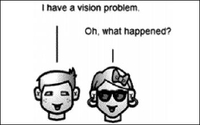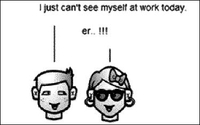Commentary
I, Comic Strip
- by Joe Mandese @mp_joemandese, January 3, 2014

One of the last tech patents to be awarded in 2013 went to
Google for a process that converts conversations between people into online comic strips. What’s the punchline? You’ll have to wait for the last panel to find out.
The
reason this story merits an RTBlog post is that it is a telling way to end a year in advertising and technology innovation. Not that automating social conversations into comics isn’t a nifty
idea, and in some ways, inherently humanizing. It’s just that in other ways, it’s part of a progression that is de-humanizing us by converting our data, behaviors, and now our
conversations, into digital fabrications of ourselves. We call them applications, but when we use them as a proxy for actual human interaction, I think fabrication is a better term.
advertisement
advertisement
My concern isn’t the random, one-off experience. Elfing yourself as one of Officemax’s singing/dancing holiday elves, or occasionally using other forms of avatar can be funny, delightful and creates a new kind of interaction between people. My concern is that every new level of digitization, and the inevitable automation -- and “optimization” -- that comes with it, just flattens us out into the two-dimensional equivalent of comic strip characters drawn in line art.
Actual comic strip characters are funny -- and very human at the heart -- because someone conceived and draw them. That’s an inherently human process called creation. Turning ourselves into comic strip characters, I believe, may have the opposite effect.

Whether you do it via programmatic trading, “big data” analytics, creative versioning, or turning peoples conversations into cartoons, the important thing is to make sure the process makes humans more human, not less. JMHO.
Oh, and about that punchline, well, you know how de-huminzation affects human productivity and workflow, right?



Back in the old days, cartoons and illustrations were recommended when the product/service you were selling made people feel uncomfortable. EG: body odor, halitosis, weight-loss, etc.
They should study this more to learn the impact on today's audience. Could be the messages wouldn't register as well. Neil Mahoney
... couple notes: First, this is an astoundingly stupid patent and should never have been awarded. The award protects the cute idea that (huge surprise) you can use software to arrange text and clip-art into something that looks like a multi-panel comic strip. Beyond that idea, there's nothing to this patent at all: no process, no code, no unique art, no science problem being solved. It's morally equivalent to Amazon's 'one click ordering.' (Except, hopefully, a lot less profitable, since one feels intuitively that the market for autogenerated comic strips is small).
Second - I wouldn't worry too much about humanity, art, or letters taking a hit because Google has figured out that putting a line-art face, a straight line, and a blurb together makes a comic. Google's contribution to the Great March Forward, here, does not include any technology that purports to make _good_ comic strips, whether we're speaking in terms of art, or -- equally important -- the written word. In fact, these things would not even be recognizable as 'comic strips' were it not for the groundbreaking work of cartoonists like Randall Munroe, Matthew Inman, Allie Brosh and others who pioneered the use of minimalist/primitive imagery (usually in combination with massively-intelligent dialogue and other text) to create powerful comic franchises on the internet. If this (cough) "technology" helps someone discover their inner Randall Munroe, I'm all for it. But in most cases, it's no more likely to produce another xkcd than are the LOLCAT-making forms on http://icanhas.cheezburger.com/